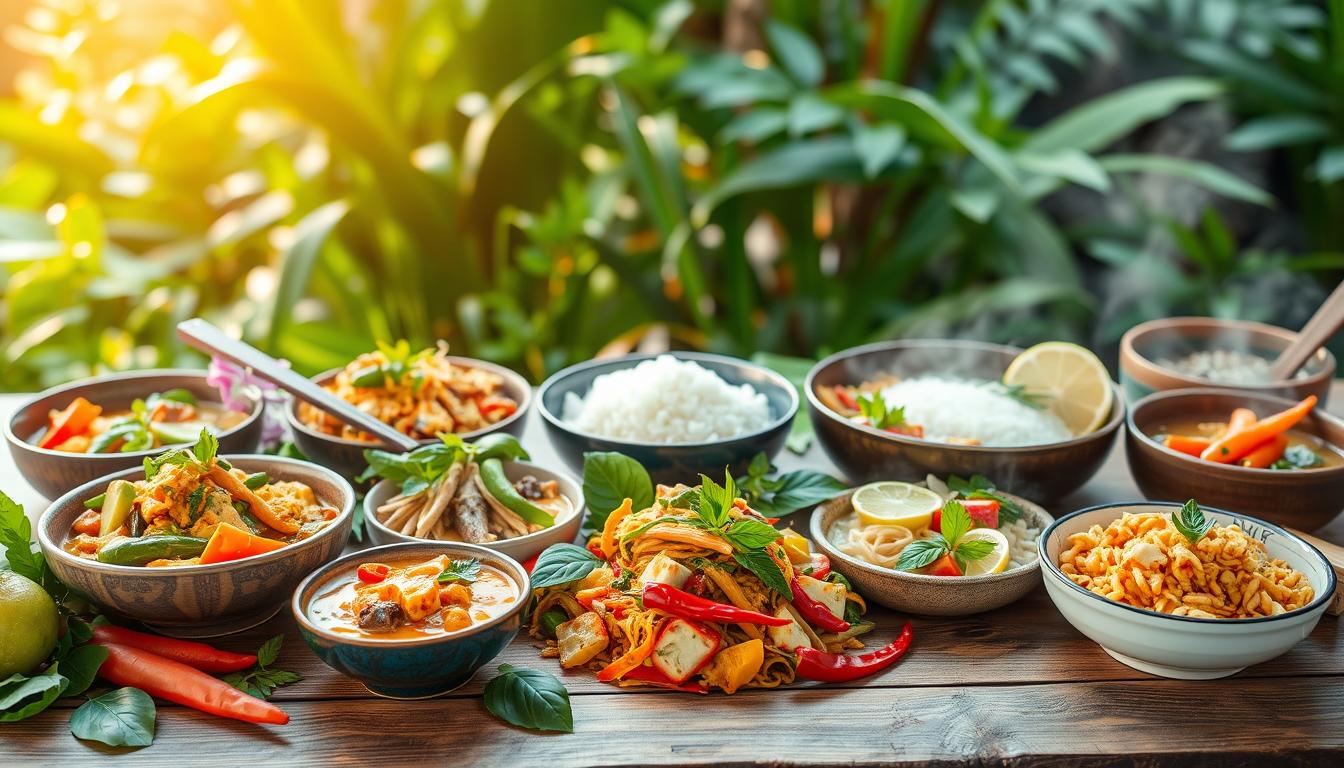Vegan & Veggie Thai Food: Plant-Based Guide
Did you know a lot of traditional Thai food is already plant-based? This makes it perfect for vegans and vegetarians.
Thai food is famous for its deep flavours and spices. These can be easily changed to fit vegan and vegetarian diets. By making a few tweaks, you can enjoy Thailand’s bold tastes while sticking to your diet.
Exploring vegan and veggie Thai food opens up a world of tasty plant-based recipes. These dishes are sure to excite your taste buds.
An Introduction to Vegan & Veggie Thai Cuisine
Vegan Thai cuisine is a vibrant and flavorful take on traditional Thai cooking. It’s made for those who follow plant-based diets. You can enjoy Thailand’s bold flavors and spices without giving up your dietary choices.
Understanding Thai Flavours
Thai cuisine is famous for its mix of sweet, sour, salty, and spicy tastes. The secret to Thai flavors is combining fresh herbs, spices, and plant-based ingredients. Lemongrass, galangal, kaffir lime leaves, and chilies are essential. They add depth and warmth to dishes.
Traditionally, Thai cooking uses fish sauce and shrimp paste. But, you can replace these with vegan options to keep the authentic taste. For example, tamari or nama shoyu can stand in for fish sauce. A mix of nutritional yeast and seaweed can mimic shrimp paste’s umami flavor.
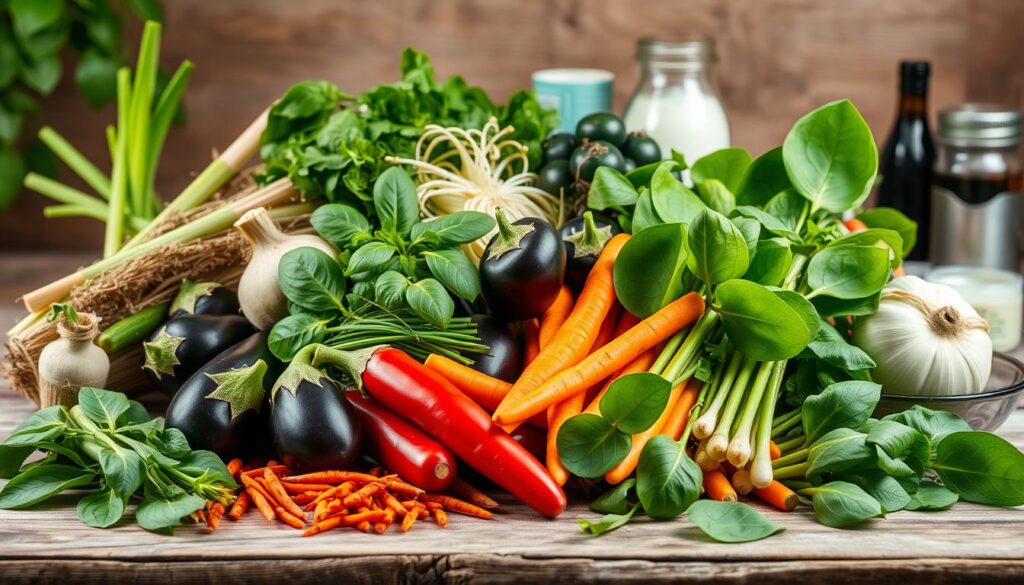
Key Ingredients in Vegan Thai Dishes
The magic of vegan Thai cuisine is in its fresh, plant-based ingredients. Some key ones are:
- Lemongrass: Adds a citrusy flavor to soups and curries.
- Kaffir lime leaves: Provides a unique, fragrant flavor to dishes.
- Galangal: Similar to ginger, it adds warmth and depth.
- Chilies: Contributes to the spicy kick characteristic of Thai cuisine.
- Coconut milk: Used to create rich and creamy curries.
By using these ingredients, you can make authentic vegan Thai dishes. They are both delicious and fulfilling.
Popular Vegan Thai Dishes You Must Try
Exploring vegan Thai food is a treat. You’ll find dishes that are both familiar and new. Thai cuisine is known for its bold flavours and spices. And you can enjoy it on a vegan diet without losing the authentic taste.
Pad Thai with a Plant-Based Twist
Pad Thai is a classic dish that can be made vegan. Swap fish sauce for a vegan alternative and use tofu instead of shrimp. This way, you can enjoy this stir-fry noodle dish without losing flavour. The secret to a great vegan Pad Thai is a tamarind-based sauce. It adds a tangy and slightly sweet taste.
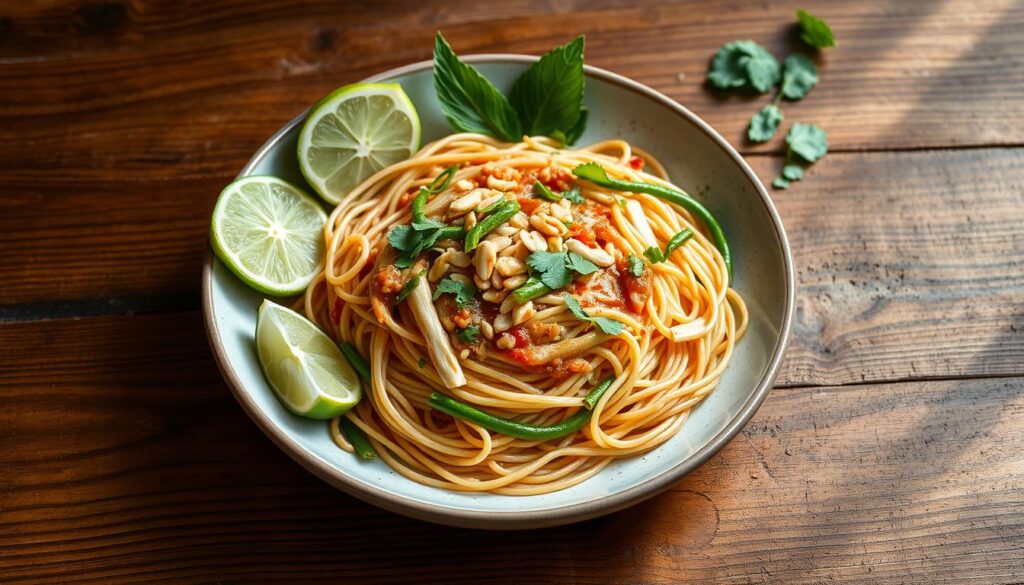
Green Curry Made Vegan
Green curry is another popular dish that can be vegan. Use coconut milk and vegan green curry paste to make a rich and creamy curry. Adding Thai basil and kaffir lime leaves will enhance the flavour. It gives it an authentic Thai taste.
Summer Rolls: Fresh and Delicious
Summer rolls are a refreshing and healthy vegan option. They’re filled with vegetables, tofu, and rice noodles. Served with sweet chilli sauce, they’re a delight. The secret to great summer rolls is using fresh ingredients. And not overfilling them, so they’re easy to roll and eat.
These vegan Thai dishes are not just delicious. They also show the diversity and richness of Thai cuisine. By using plant-based ingredients and avoiding animal products, you can enjoy the authentic taste of Thailand. All while following a vegan diet.
Essential Thai Herbs and Spices for Vegan Cooking
To make your vegan kitchen taste like Thailand, you need to know about key herbs and spices. Thai food is famous for its rich and balanced flavors. Herbs and spices are key to getting this right.
Thai cooking stands out because of its fresh and aromatic ingredients. In vegan Thai cooking, some herbs and spices are must-haves. They make dishes not just tasty but also true to Thai tradition.
Lemongrass: The Citrus Wonder
Lemongrass is a must-have in Thai cooking, adding a zesty flavor. It’s used in soups, curries, and marinades. To get the most from lemongrass, bruise it before adding it to your dishes. This releases its oils.
Key uses for lemongrass include:
- Adding it to soups and curries for a fresh flavor
- Using it in marinades for grilled vegetables and tofu
- Incorporating it into salad dressings for a citrus twist
Kaffir Lime Leaves: A Fragrant Addition
Kaffir lime leaves are vital in Thai cooking, adding a unique scent and taste. They’re used in soups, curries, and stir-fries. You can use them whole or torn to release their oils.
Some ways to use kaffir lime leaves include:
- Adding whole leaves to soups and curries for added depth
- Tearing the leaves to release their oils in stir-fries
- Using them in combination with lemongrass for a classic Thai flavor profile
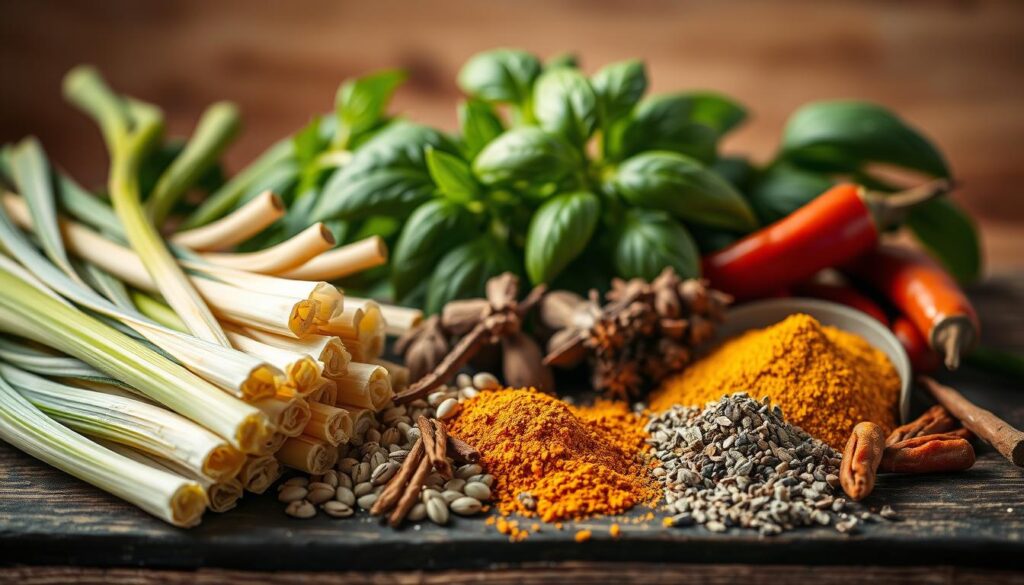
Cooking Techniques for Veggie Thai Food
Veggie Thai food is all about the techniques. Let’s explore stir-frying, steaming, and currying. Mastering these methods will help you make delicious, plant-powered Thai meals that are both healthy and tasty.
Stir-Frying: Quick and Tasty
Stir-frying is key in Thai cooking. It involves quickly cooking ingredients in a wok or large pan over high heat. This method keeps vegetables’ texture and color, blending flavors well.
To stir-fry like a pro, start with oil, garlic, and ginger. Then add your favorite vegetables and seasonings.
Tips for effective stir-frying:
- Use a hot wok or pan to prevent ingredients from sticking.
- Stir constantly to ensure even cooking.
- Add ingredients in the right order, starting with aromatics like garlic and ginger.
Steaming: Preserving Nutrients
Steaming is vital in Thai cuisine. It helps keep nutrients and flavors in ingredients. It’s great for cooking vegetables, tofu, and other plant-based proteins.
To steam effectively, use a steamer basket over boiling water. Cover with a lid to trap the steam.
Benefits of steaming:
- Preserves the color and texture of vegetables.
- Retains nutrients that might be lost through other cooking methods.
- Requires minimal oil, making it a healthier option.
Currying: Building Flavours Gradually
Currying involves slowly simmering ingredients in a rich sauce. This method blends flavors, creating a deep taste. To curry, start with a curry paste of aromatics and spices. Then add coconut milk or other liquid for a creamy sauce.
Key elements of currying:
- Use a mixture of spices and aromatics to create a flavorful curry paste.
- Simmer the curry sauce slowly to allow the flavors to develop.
- Adjust the seasoning and consistency to taste.
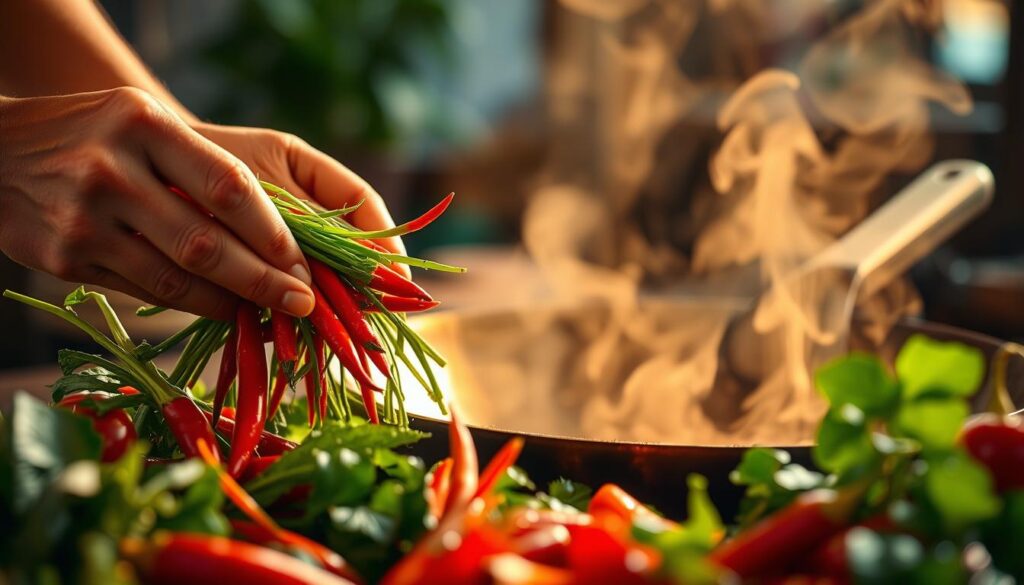
Where to Find Vegan Ingredients for Thai Cooking
Finding vegan ingredients for Thai cooking is easy with the right tips. You’ll learn that the right ingredients are key for true Thai flavors.
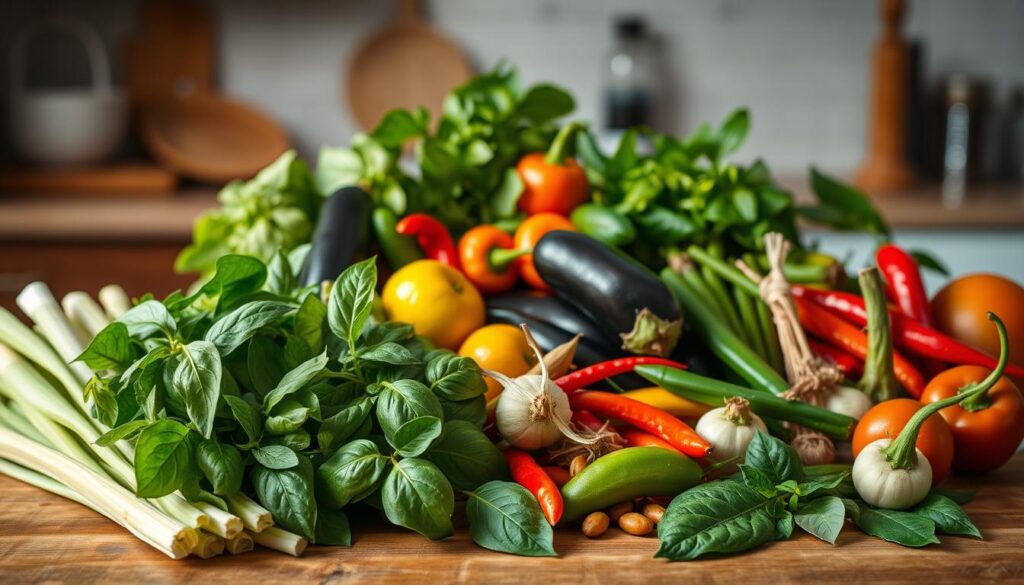
Local Asian Markets: A Treasure Trove
Start your search at local Asian markets. They have a wide range of herbs, spices, and plant-based items. You’ll find fresh lemongrass, kaffir lime leaves, and vegan sauces and pastes.
Look for these essential items:
- Fresh vegetables like Thai basil and chilies
- Grains such as rice noodles and jasmine rice
- Protein sources like tofu and tempeh
- Specialty ingredients like vegan fish sauce alternatives
Online Grocery Stores: Convenience at Your Fingertips
Online grocery stores are great for shopping from home. They offer a wide selection of vegan ingredients for Thai cooking.
Online, you can:
- Search for specific ingredients using the website’s search function
- Read product reviews to ensure you’re getting high-quality ingredients
- Take advantage of filters to narrow down your search to vegan products
By checking out local markets and online stores, you’ll find many vegan ingredients. They’ll help make your Thai cooking even better.
Tips for Perfecting Your Vegan Thai Recipes
To master vegan Thai cooking, you need to understand the delicate balance of flavors. Thai cuisine is known for its bold and aromatic dishes. These are made by mixing sweet, sour, salty, and spicy flavors. In vegan Thai cooking, getting this balance right is key to making authentic and tasty dishes.
Balancing Flavours: Sweet, Sour, Spicy
Balancing flavors is an art that needs attention and experimentation. To get the perfect mix, you must know how each ingredient affects the flavor. For example, sweetness can be added with palm sugar or maple syrup. Sourness can come from tamarind or lime juice. Spiciness can be adjusted with chili peppers or Thai chilies.
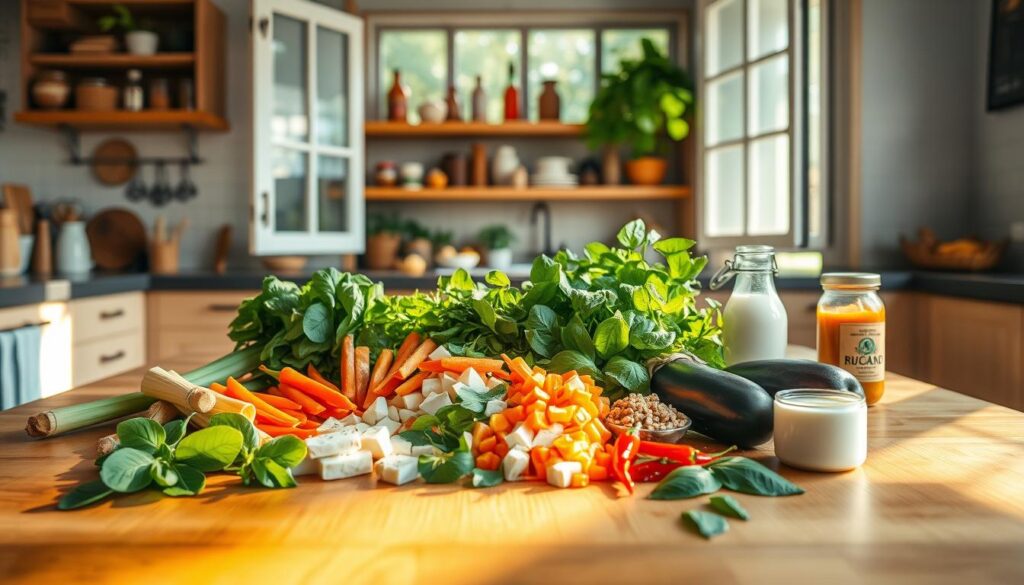
When balancing flavors, tasting as you go is essential. Adjust the seasoning as needed. You can also play with the ratios of sweet, sour, and spicy to suit your taste.
Experimenting with Ingredients
Trying out different ingredients can make your vegan Thai recipes more interesting. You can swap protein sources like tofu or tempeh. Or, you can use various vegetables and herbs. For instance, using different mushrooms or adding fresh herbs like basil or cilantro can create unique flavors.
- Try different non-dairy milks, like coconut or almond milk, for creaminess.
- Experiment with spices and seasonings, such as turmeric or galangal, for depth and warmth.
- Don’t hesitate to try new ingredients, like jackfruit or lotus root, for texture and interest.
By experimenting with ingredients and flavors, you can make innovative and delicious vegan Thai recipes. These are sure to impress anyone.
Pairing Vegan Thai Dishes with Beverages
Choosing the right drink can make your vegan Thai meal even better. Whether you’re cooking at home or eating out, the right drink can bring out the best in Thai food.

Traditional Thai Iced Tea: Vegan Version
Thai iced tea is a favourite that can be made vegan. Just swap the dairy milk for a plant-based one. Almond, coconut, or oat milk works well for a creamy, cool drink.
To make vegan Thai iced tea:
- Start with a strong black tea or Thai tea mix.
- Choose your favourite plant-based milk.
- Add sweetener like coconut sugar or maple syrup to taste.
- Serve over ice with cinnamon or star anise for extra spice.
Suggested Alcoholic Beverages
If you like a drink with your meal, here are some good choices:
- Thai Beer: A cold beer can balance the richness of curries.
- Singha or Chang Beer: These Thai beers match spicy and sour tastes.
- Coconut Mojito: A twist on the classic, with coconut rum and mint.
- Lime and Ginger Martini: A zesty cocktail that goes well with Thai food’s bright flavours.
Choosing the right drink can make your vegan Thai meal even more enjoyable. It brings out the rich flavours of Thai cuisine.
Dining Out: Finding Vegan Thai Restaurants in the UK
Finding vegan Thai options in the UK is now easier than ever. Many Thai restaurants offer vegan-friendly dishes. This makes it simple to enjoy your favourite cuisine while sticking to your dietary preferences.

Top Cities for Vegan Thai Food
The UK has a vibrant vegan community. Some cities are known for their amazing vegan Thai food. You can find great vegan Thai dishes in:
- London, with its many vegan-friendly restaurants.
- Manchester, famous for its vegan scene.
- Bristol, a city that loves vegan diners.
These cities have a variety of Thai restaurants that serve vegan diets. They offer traditional curries and new vegan twists on classic dishes.
What to Look for on the Menu
When eating at a Thai restaurant, it’s key to know what to look for on the menu. Here are some tips:
- Look for dishes marked as ‘vegan’ or ‘suitable for vegans’.
- Choose dishes that are naturally vegan, like vegetable stir-fries or tofu curries.
- Ask your server about the ingredients and how dishes are made.
By following these tips, you can have a great dining experience at vegan Thai restaurants in the UK.
Creating a Vegan Thai Dinner Party
You’ve learned how to cook vegan Thai dishes. Now, it’s time to share them with friends at a dinner party. A great evening is more than just tasty food; it’s about creating a memorable experience.
Dishes to Impress Your Guests
For a fantastic menu, mix different textures and flavours. Begin with Tom Yum soup. Then, serve Pad Thai or a vegan Green Curry. Add Summer Rolls as a starter or side dish.
Setting the Scene
Turn your dining area into a Thai paradise with simple decor. Use natural materials like woven rattan and bamboo. Add warmth with candles and soft lights.
Incorporate traditional Thai elements. This could be intricately carved wooden decorations or vibrant silk fabrics. These touches will make your vegan dinner party truly special.

